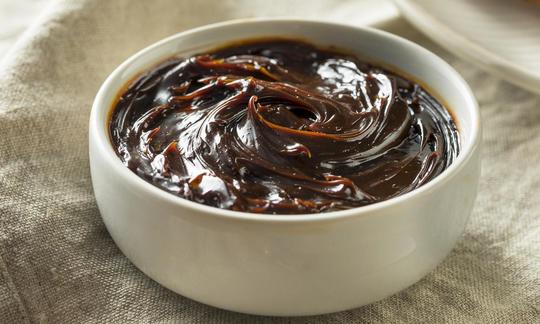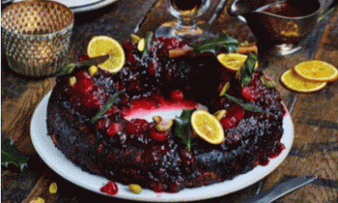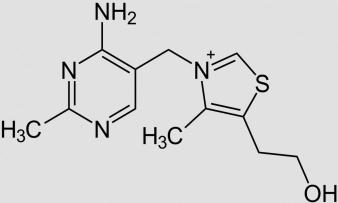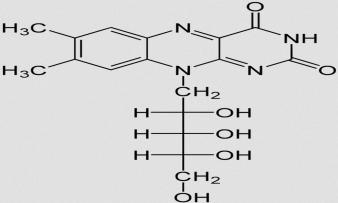Vegetarian and vegan spice pastes based on yeast extract (or yeast-based spice pastes) are increasingly being used in various preparations as flavor-enhancing additives. The taste of such yeast extracts is often referred to as umami. For the sake of your health, however, you should use them rarely.
Use in the kitchen:
The generally viscous, dark brown, salty-spicy tasting pastes are more or less salted and seasoned concentrates from yeast cells. They are mainly used as a spread on bread. When poured over hot water, the yeast extracts are also suitable as a bouillon or for seasoning soups, stews or braised dishes. Marinades, sauces or vinaigrettes can also be refined with them. The food industry usually uses yeast-based spice pastes as a seasoning in ready-made sauces, soups or other ready-made dishes.
In Great Britain, the pastes are part of everyday consumption: spread on hot toast, with cheese, in a cheese soup or as a snack with tomatoes and onions, served with baked cheese. Only add the spice paste immediately before consumption, as the heat destroys some of the vitamins.
There are even cocktails (such as Marmite Cocktail and Marmite Cocktail Gold Rush) or panini recipes (Starbucks) that are inspired by yeast pastes.
Vegan recipes with yeast-based spice paste:
Due to the yeast extract they contain, these spice pastes act like a flavor enhancer. In addition, their high salt content is often noticeable. However, if you combine yeast extract with many healthy ingredients, you can enjoy it every now and then, for example on special occasions in exquisite recipes such as the Festive Nut Wreath with Butternut Squash, Chestnuts and Nuts.
| Not only vegans or vegetarians should read this: Vegans often eat unhealthily. Avoidable nutritional errors. |
Shopping - where to buy?
You can get the spice pastes with an umami flavour in practically all well-stocked shopping centres. One of the best known examples is Marmite yeast extract from the Unilever group, which sells it in small 125 ml screw-top jars or squeeze bottles. You can find Marmite in supermarkets such as Coop, Migros (in Switzerland), Rewe, Edeka (Germany) or in online shops. We found no information about it at Denner, Volg, Spar, Aldi, Lidl or Hofer. Some health food stores or specialty shops also stock Marmite. In Germany there is a similar product called 'Vitam-R', in Switzerland people eat 'Cenovis' on their bread and butter, in Australia they use 'Vegemite'.
Storage:
Like all spices or seasonings, spice pastes should be stored in a cool, dark place. Opened products are best kept in the refrigerator and consumed as quickly as possible.
Ingredients - nutritional value - calories:
Marmite or similar spice pastes consist mainly of yeast extract. Depending on the product, the energy content is between 154 and 250 kcal/100g, of which around 12-24% are carbohydrates and 20-29% are protein. The fat content is almost zero, but the pastes contain quite a lot of salt at 8.5-9.8 g/100g. Even low-salt versions, which are preferable to regular products, should only be consumed in moderation.
Yeast is often present in large quantities, as it is a by-product of many food processing processes. What is the difference between yeast and yeast extract? For spice pastes such as Marmite, yeast cultures are used from baker's yeast or brewer's yeast (which is produced during alcoholic fermentation when brewing beer). These yeast cells are opened up by autolysis and a cell juice is released. This juice is very rich in protein. Further enzymatic processes break down the components into individual amino acids. This is what gives the yeast its typical taste. It also contains glutamic acid, which acts as a flavor enhancer: yeast pastes usually contain 4-5%, 7 and in powder form the content is around 10%, sometimes even more. 1,8,9
The extract is initially liquid, but further concentration and filtering solidifies it into a paste 10 and the bitter substances are removed. 11 Salt, plant extracts and spices are then added, but the exact composition is not known (company secret). Yeast extract is available not only as a paste, but also as a spray-dried powder. The latter is preferred by the food industry.
Yeast extracts are rich in many B vitamins. But to enhance the product (also as a dietary supplement), other vitamins are added such as thiamine (vitamin B1), niacin / nicotinic acid (vitamin B3), riboflavin (vitamin B2), folic acid / folate and cobalamin (vitamin B12). Potassium, selenium, magnesium and zinc are also present.
The complete ingredients, the coverage of the daily requirement and comparison values with other ingredients can be found in our nutrient tables. In the article Nutrients explained you will get a detailed insight into the topic. CLICK FOR before the text.
Health aspects - effects:
How healthy is yeast extract? B vitamins are very important for the human body. They support metabolic processes, nerves and muscles. However, vegetarians and vegans can meet their thiamine requirements more naturally through a varied selection of whole grains, nuts and pulses. Foods rich in riboflavin are whole grains, seeds, pulses and yeast flakes. Niacin can also be found in green leafy vegetables and folic acid is found in pulses, brassicas, green leafy vegetables and whole grain products.
Is yeast vegan? Yeast, whether brewer's yeast or baker's yeast, consists of single-celled fungi. They have no central nervous system and do not feel pain. This means that yeast can be classified as completely vegan.
For information about problematic ingredients in yeast pastes, please read the following chapter.
Dangers - Intolerances - Side effects:
Yeast extracts are an industrially modified ingredient and unhealthy in large quantities. Therefore, try to use products made from or containing yeast extract sparingly. Yeast extracts (yellow-brown powders or dark brown pastes) were long considered the better alternative to artificially produced glutamate because they have a similar effect. But these natural yeast extracts are now also controversial because of their high glutamate content (glutamates are the salts of glutamic acid). The problem is that yeast extract is not a food additive and is not officially designated as a flavor enhancer (unlike industrially produced monosodium glutamate E 621 or other glutamates in isolated form). It is therefore possible that yeast extract is hidden behind the terms "natural flavors", "seasoning" or "seasoning" when declaring ingredients. "Spices" or "spice mixtures", on the other hand, refer exclusively to dried plant parts. 12 Even products with the EU organic seal 13 may contain yeast extract - but glutamate is prohibited there.
Unfortunately, the glutamic acid in yeast paste - like other flavor enhancers - blocks the feeling of satiety and we quickly eat too much. 14 Organic yeast extract is not really any better and we recommend using natural herbs and spices to improve and intensify the flavor.
In 2006 and the following years, a scientific debate broke out about the tolerability or harmfulness of glutamates, which called into question the credibility of numerous studies. 15 The Federal Institute for Risk Assessment ( BfR) and the European Commission 16 consider the use of monosodium glutamate as an additive in food to be safe, although many consumers report hypersensitivity reactions. 17
An important aspect that most vegetarian yeast-based spice pastes have in common is their relatively high salt content. An unbalanced high salt consumption is associated with an increased risk of hypertension (high blood pressure) as well as increased cardiovascular risks and other organ-damaging secondary diseases. 3,4 For this reason, the WHO also recommends keeping sodium intake below 2 grams per day, which corresponds to less than 5 grams of salt per day (≈ ¾ teaspoon). 5 On the referenced website of the health organization you will find further information, guidelines and scientific publications that refer to the dangers associated with increased salt consumption.
All yeast products, especially yeast extract, are characterized by a very high purine content and are therefore not recommended for gout patients.
People with gluten intolerance will hopefully be aware that brewer's yeast can contain small amounts of gluten. Legally, yeast extracts are considered gluten-free because the gluten content is less than 20 ppm, but we recommend that very sensitive people avoid them. 2
In combination with monoamine oxidase inhibitors (MAOIs) or inhibitors (MAOIs), tyramine-rich foods such as yeast extracts can trigger dangerously high blood pressure. 18
General information:
Yeast, baker's yeast or top-fermenting brewer's yeast ( Saccharomyces cerevisiae) are fungi that multiply with the help of moisture and heat in a nutrient medium (e.g. sugar, flour). Cell division or budding takes place at temperatures of around 28 °C.
Justus Liebig (a German scientist and chemist) was at the beginning of yeast extract production with his discovery that yeast could be concentrated and eaten. In 1902, the Marmite Food Extract Company opened in Burton upon Trent (England), where the raw material brewer's yeast (a waste product from breweries) was available in large quantities. This company achieved commercial success with the yeast paste 'Marmite', which it was able to expand greatly from 1912 onwards thanks to the discovery of vitamins.
The myth that eating Marmite or other vitamin B-rich products will repel mosquitoes is a long-standing one. Many Brits take Marmite with them when they travel to protect themselves from bites. However, there is no scientific evidence to support this. 6
Alternative names:
The following alternative names are in circulation for yeast-based (or yeast extract-based) spice pastes: yeast extract, yeast extract, yeast paste, autolysed yeast, hydrolysed yeast, vegetarian meat extract and brand names such as Marmite, Cenovis, Cenovit (Brazil), Vegemite, AussieMite, Mightymite, New Zealand Marmite, Promite, Vitam-R. Bovril replaced beef extract with yeast extract in 2005-2006. 19
Marmite is French for a large, covered cooking pot made of earthenware or metal. A drawing of this ancient cooking pot can be found on the product's logo and the shape of today's sales containers is intended to remind us of it.
In English, yeast extract is called yeast extract or yeast autolysate, 20 spice paste based on yeast is translated as yeast extract spread or spread based on yeast extract.
Keywords for use:
According to Wikipedia, yeast extracts flavor various ready meals and snacks, frozen products, ready-made sauces, pre-made soups and even crackers or potato chips. 19 In 2018, the Irish Times pointed out that frozen chips often contain yeast extract in addition to other unhealthy additives. 21 Be careful with organic products such as bouillon or organic chips! 13
Are yeast flakes yeast extract? Most unseasoned yeast extracts - similar to nutritional yeast (yeast flakes) - are also used in sick nutrition 22 or as a food supplement (liquid or powder). However, they are not the same product, as the manufacturing methods are different.
In recent years, there has been an increasing demand for yeast extract as a component of microbiological and cell culture media (e.g. by pharmaceutical companies). 19
Literature - Sources:
Bibliography - 22 Sources (Link to the evidence)
| 1. | Dong J et al. Research on production of Yeast extract and the use thereof in condiments industry. Science and Technology of Food Industry 24 (05), 31 December 2003, S. 103-105. |
| 2. | Hefeextrakt.info FAQ. |
| 3. | Strazzullo P, D'Elia L et al. Salt intake, stroke, and cardiovascular disease: meta-analysis of prospective studies. BMJ. 2009 Nov 24; DOI: 10.1136/ bmj.b4567 |
| 4. | Farquhar WB, Edwards DG et al. Dietary sodium and health: more than just blood pressure. J Am Coll Cardiol. 2015 Mar 17. DOI: 10.1016/ j.jacc.2014.12.039 |
| 5. | World Health Organization: WHO. WHO issues new guidance on dietary salt and potassium. 31 January 2013. |
| 6. | Ives AR, Paskewitz SM. Testing vitamin B as a home remedy against mosquitoes. Journal of the American Mosquito Control Association. 2005;21. |
| 7. | Google Patent: EP2368444A1. Yeast Extract with high glutamic acid content and producing method thereof. 2015. |
| 8. | Podpora B, Świderski F et al. Spent brewer’s yeast extracts as a new component of functional food. Czech J. Food Sci. 2016;34: 554–563. |
| 9. | Eisenbrand G, Schreier P (Hrsg.): Römpp-Lexikon Lebensmittelchemie. Lebensmittelrecht bearbeitet von Alfred Hagen Meyer. 2., völlig überarbeitete und erweiterte Auflage. Thieme, Stuttgart 2006, S. 494f. |
| 10. | Baines D, Seal R. Natural Food Additives, Ingredients and Flavourings. Woodhead Publishing Series in Food Science, Technology and Nutrition. Elsevier Science. 2012: p. 296. |
| 11. | Tanguler H, Erten H. Utilisation of spent brewer's yeast for yeast extract production by autolysis: The effect of temperature. Food and bioproducts processing. Elsevier. 2008. |
| 12. | Verbraucherzentrale Bundesverband e.V. Zählt Hefeextrakt zu den Geschmacksverstärkern? |
| 13. | Schönbrodt C, Schinkowski N et al. Einsatz von Hefeextrakt in Bio-Lebensmitteln Bundesministerium für Ernährung, Landwirtschaft und Verbraucherschutz im Rahmen des Bundesprogramms Ökologischer Landbau (BÖL). |
| 14. | Hermanussen M et al. Obesity, voracity and short stature: The impact of glutamate on the regulation of appetite. European Journal of Clinical Nutrition,2006; 60:25-31. |
| 15. | Hermanussen M. No consensus on glutamate. European Journal of Clinical Nutrition. 2008; 62:1252-1253. |
| 16. | Schriftliche Anfrage E-0119/01 von Ria Oomen-Ruijten (PPE-DE) an die Kommission zu möglichen Gesundheitsrisiken durch die Geschmacksverstärker E621 und E632 (Glutamat). |
| 17. | Bundesinstitut für Risikobewertung (BfR). Überempfindlichkeitsreaktionen durch Glutamat in Lebensmitteln. 2003. |
| 18. | Stahl SM, Felker A. Monoamine oxidase inhibitors: a modern guide to an unrequited class of antidepressants. CNS spectrums. 2008; 13 (10), S. 855–870. DOI: 10.1017/s1092852900016965 |
| 19. | Wikipedia Englisch Yeast Extract. |
| 20. | Joseph R., Bachhawat AK et al. Yeast Lysates and Yeast Extract, in Encyclopedia of Food Microbiology (Second Edition). 2014. |
| 21. | irishtimes.com Do you really know what exactly is in your frozen chips? 3. April 2018. |
| 22. | ihatemarmite.com. A brief history of Marmite. Archived from the original on 24 March 2012. |









Comments